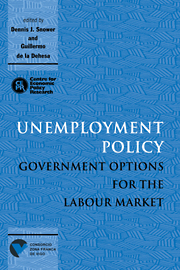Book contents
- Frontmatter
- Contents
- List of figures
- List of tables
- Preface
- Acknowledgements
- List of conference participants
- 1 Introduction
- PART ONE GENERAL POLICY ISSUES
- PART TWO DEMAND MANAGEMENT AND SUPPLY-SIDE POLICY
- PART THREE SUBSIDISING EMPLOYMENT AND TRAINING
- 6 The simple economics of benefit transfers
- Discussion
- Discussion
- 7 Wage subsidy programmes: alternative designs
- Discussion
- Discussion
- 8 Technological development, competition from low-wage economies and low-skilled unemployment
- Discussion
- 9 Macroeconomic and policy implications of shifts in the relative demand for skills
- Discussion
- 10 Would cutting payroll taxes on the unskilled have a significant impact on unemployment?
- Discussion
- 11 Preventing long-term unemployment: an economic analysis
- Discussion
- Discussion
- PART FOUR LABOUR MARKET REGULATIONS
- PART FIVE POLICY, JOB REALLOCATION AND THE UNEMPLOYMENT–PRODUCTIVITY RELATION
- PART SIX COMPARING UNEMPLOYMENT POLICIES
- Index
Discussion
Published online by Cambridge University Press: 07 September 2010
- Frontmatter
- Contents
- List of figures
- List of tables
- Preface
- Acknowledgements
- List of conference participants
- 1 Introduction
- PART ONE GENERAL POLICY ISSUES
- PART TWO DEMAND MANAGEMENT AND SUPPLY-SIDE POLICY
- PART THREE SUBSIDISING EMPLOYMENT AND TRAINING
- 6 The simple economics of benefit transfers
- Discussion
- Discussion
- 7 Wage subsidy programmes: alternative designs
- Discussion
- Discussion
- 8 Technological development, competition from low-wage economies and low-skilled unemployment
- Discussion
- 9 Macroeconomic and policy implications of shifts in the relative demand for skills
- Discussion
- 10 Would cutting payroll taxes on the unskilled have a significant impact on unemployment?
- Discussion
- 11 Preventing long-term unemployment: an economic analysis
- Discussion
- Discussion
- PART FOUR LABOUR MARKET REGULATIONS
- PART FIVE POLICY, JOB REALLOCATION AND THE UNEMPLOYMENT–PRODUCTIVITY RELATION
- PART SIX COMPARING UNEMPLOYMENT POLICIES
- Index
Summary
Professor Phelps in chapter 7 provides strong and eloquent arguments supporting market intervention on behalf of low-wage workers. By encouraging the employment of low-income workers at higher wages, a wage subsidy would offset incentives to engage in negative social behaviour and would strengthen positive social values, the work ethic and respect for private property. A low-wage subsidy is needed to offset the recent rise in income inequality, whatever its source. Finally, a wage subsidy would reduce wasteful unemployment induced by imperfections associated with bargaining, rationing, and incentive wage policies.
The specifics of design that are discussed in chapter 7 seem to be sensible and useful. Phelps' efforts directed at proposing a programme that would minimise abuse by employers are of obvious practical importance. After restricting the subsidy to full-time workers only and then graduating it to reduce the incentive for fraud, Phelps uses US data for 1990 to obtain a cost estimate of $110 billion to bring hourly earnings up to $7 per hour for the lowest paid. However laudable and even though small relative to a $6 trillion economy, as he points out, this number is large in the current US political environment. Frankly, it would be difficult to imagine that such a programme would form a plank in either party's platform in the near future. However, if the US earnings distribution continues to widen and/or low-wage unemployment attains European levels, income redistribution of this form may well be on the agenda of the twenty-first century.
- Type
- Chapter
- Information
- Unemployment PolicyGovernment Options for the Labour Market, pp. 247 - 249Publisher: Cambridge University PressPrint publication year: 1997



